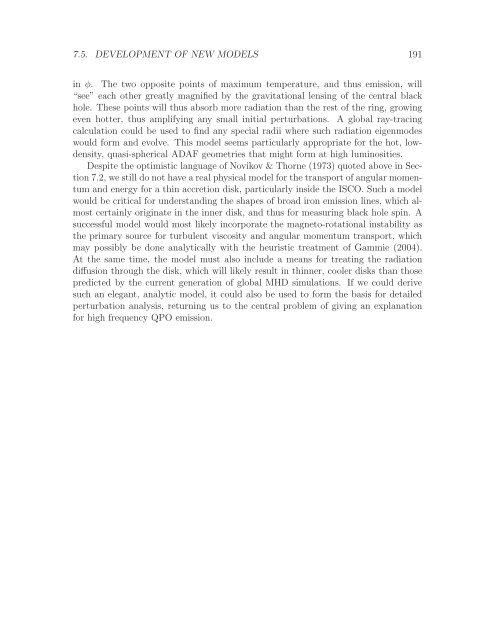Radiation Transport Around Kerr Black Holes Jeremy David ...
Radiation Transport Around Kerr Black Holes Jeremy David ...
Radiation Transport Around Kerr Black Holes Jeremy David ...
You also want an ePaper? Increase the reach of your titles
YUMPU automatically turns print PDFs into web optimized ePapers that Google loves.
7.5. DEVELOPMENT OF NEW MODELS 191<br />
in φ. The two opposite points of maximum temperature, and thus emission, will<br />
“see” each other greatly magnified by the gravitational lensing of the central black<br />
hole. These points will thus absorb more radiation than the rest of the ring, growing<br />
even hotter, thus amplifying any small initial perturbations. A global ray-tracing<br />
calculation could be used to find any special radii where such radiation eigenmodes<br />
would form and evolve. This model seems particularly appropriate for the hot, lowdensity,<br />
quasi-spherical ADAF geometries that might form at high luminosities.<br />
Despite the optimistic language of Novikov & Thorne (1973) quoted above in Section<br />
7.2, we still do not have a real physical model for the transport of angular momentum<br />
and energy for a thin accretion disk, particularly inside the ISCO. Such a model<br />
would be critical for understanding the shapes of broad iron emission lines, which almost<br />
certainly originate in the inner disk, and thus for measuring black hole spin. A<br />
successful model would most likely incorporate the magneto-rotational instability as<br />
the primary source for turbulent viscosity and angular momentum transport, which<br />
may possibly be done analytically with the heuristic treatment of Gammie (2004).<br />
At the same time, the model must also include a means for treating the radiation<br />
diffusion through the disk, which will likely result in thinner, cooler disks than those<br />
predicted by the current generation of global MHD simulations. If we could derive<br />
such an elegant, analytic model, it could also be used to form the basis for detailed<br />
perturbation analysis, returning us to the central problem of giving an explanation<br />
for high frequency QPO emission.
















